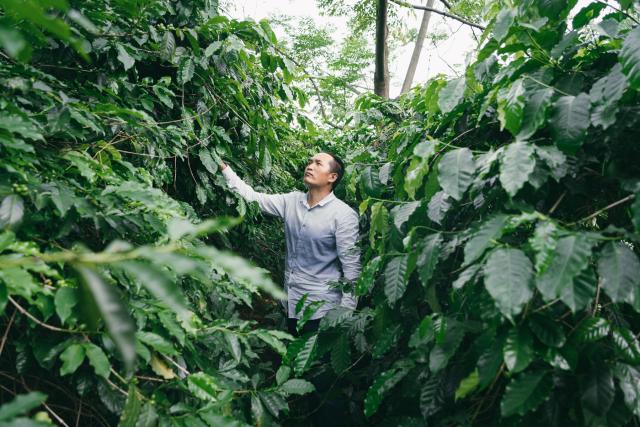Are there any coffee-growing areas in China that are suitable for growing coffee beans in Northeast China?

Professional coffee knowledge exchange More coffee bean information Please pay attention to coffee workshop (Weixin Official Accounts cafe_style)
Goats on high.
In ancient Abyssinia (present-day Ethiopia) in the 6th century AD, a flock of goats ate red fruit from a tree and were extremely excited. A flock of goats actually got high.
This strange phenomenon attracted the attention of shepherd Qadir, who suddenly felt that he was out of place with a flock of goats (er... A human and a goat can't be any better.)
With doubt, Kadir followed the goat and finally found out that the goat ate strange red fruit before it became incompatible with himself. Then he decided he wanted to taste the strange red fruit himself (God knows what kind of inner struggle he was going through), and he found it, ate one, walked fast, three...
Coffee was discovered just like that.
Coffee spread, spread to China
Coffee was discovered in Ethiopia, Africa, and spread completely in Africa and western countries for more than a thousand years. The first recorded cultivation of coffee beans in China was in Taiwan in 1884.
Coffee cultivation began in the mainland in 1902 and was brought to Binchuan County in Yunnan Province by a French missionary. From that time to now, only Yunnan Province in China's vast mainland can grow coffee.
In 1982, French missionaries came to Yunnan, in order to satisfy their appetite, so he brought the first coffee beans in Yunnan! Ten years later, there were scattered shadows of coffee trees in Binchuan County, and even locals planted coffee trees as ornamental trees in their own yards.
Slowly, slowly, a unique coffee culture has formed locally! Give the coffee beans a life that is clearly arranged in a traditional, hand-crafted way. First of all, after the coffee is picked, it is dried first, and then the coffee beans are shelled in the way of "cracking melon seeds". Yes, that's right! It was a handful of coffee beans in his left hand, a bowl in his right hand, beans delivered in his left hand, beans received in his right hand, a group of three aunts, seven aunts and eight aunts, chatting about home while knocking coffee beans, successfully making this "melon seed method" sit firmly on the number one seat of local ancient coffee making at that time.
It is also this unique coffee culture that slowly integrates coffee into the lives of local people and has become one of the main economic pillars of local people.
The unique geographical location gives coffee the conditions to grow
To grow coffee is not just to find a piece of land, bury seeds, water on the line, coffee needs a unique growth environment.
Most of the world's coffee is grown in the equatorial north and south latitudes of 23.5 degrees, in the relatively high hillside, adequate rainfall, annual average temperature above 20 ° C, if the light is too strong, but also to coffee "shade."
The planting slope should not be too steep, otherwise it is not conducive to planting, harvesting and fertilizer conservation. The hilltops and ridges cannot be planted. They must be south-facing, free of frost and calm wind in winter.
The soil must be rich in organic matter, strong in fertilizer retention, abundant in moisture, unobstructed in drainage, and weakly acidic to be suitable for growing coffee.
It had to be said that coffee was really a strange plant. It was not delicate, but it had to be nurtured. And these unique conditions, in our country, only two places are suitable for growing coffee, one is Taiwan, the other is Yunnan.
Strong but not bitter, fragrant but not strong Yunnan coffee
Today, Yunnan mainly planted coffee in Dehong, Baoshan, Pu 'er, Simao, Banna these places, mainly planted Arabica, commonly known as: Yunnan small coffee.
In recent years, Yunnan Arabica coffee has been more and more recognized internationally, and even appeared in the New York Times. 95% of coffee in China now comes from Yunnan. At the same time, Yunnan coffee raw materials are also exported to foreign countries for Nestle and Starbucks. Many people think that coffee is imported, but they don't know that a lot of coffee is produced from Yunnan, but it becomes imported after several twists and turns after export.
After a century of tempering, the quality of Yunnan coffee is getting better and better now. Don't always say that there is no good coffee in China. Maybe you just didn't choose the right one! One step at a time, the unique aroma of Yunnan coffee was gushing out from the teapot mouth and drifting into the distance…
Yunnan, China
the history of coffee
At the end of the 19th century, coffee was first introduced to China from the southwestern province of Yunnan by a French missionary. Coffee production temporarily disappeared in the following century (or more) until 1988, when the Chinese government launched a project with the World Bank and the United Nations Development Programme to restart coffee production. Large companies such as Nestl é have also promoted coffee cultivation in the region, and the related production trend has soared.
Yunnan Cajun is picking coffee fruits.
The main growing area of coffee is still in Yunnan Province, where coffee accounts for more than 95% of China's coffee production. The famous "Pu'er tea" comes from the traditional tea growing area of Yunnan province and city. However, due to the mountain landscape (the average elevation is about 2000 meters) and the mild climate, it is very suitable for coffee production. Yunnan, bordering Vietnam, Laos and Myanmar, is located in the center of the coffee production belt. The province, which covers an area of 394000 square kilometers and has a population of 46 million, mainly produces Arabica coffee. In addition, a small part of robusta coffee is grown on Hainan Island (South China, southeastern Fujian Province).
Coffee warehouse
Coffee production in China has developed rapidly in the past two decades. According to the World Food and Agriculture Organization (FAO), production reached 1.9 million bags in 2013, doubling about every five years. That would make China the world's 14th largest coffee producer, ahead of Costa Rica and second only to Nicaragua, up from 30th in the world a decade ago, producing just 361000 bags.
Brew a cup of Yunnan coffee
At present, there is controversy on the quality of coffee produced in China. They are usually considered to be not up to professional coffee standards, but it is too high to be used purely for local consumers. Most of the Arabica coffee produced here is fully washed Kadim, but other varieties, including tin pickup and bourbon, have recently begun to be involved, which can bring higher returns.
Coffee roasting
The flavor of coffee produced in China is most similar to that of Central American coffee. In the cup test, you will taste a medium acidity with nutty, chocolate, herbal and earthy flavors. We usually bake them to medium and dark, but they maintain good quality under all kinds of baking conditions. Most of the coffee grown in China is processed by wet processing, and some farms try to produce naturally processed coffee. The history of coffee production in China is still very short, and they are experimenting with different varieties and processing technologies, so they have many opportunities for improvement. I look forward to seeing how coffee production here will improve and improve in the next five to ten years.
END
Important Notice :
前街咖啡 FrontStreet Coffee has moved to new addredd:
FrontStreet Coffee Address: 315,Donghua East Road,GuangZhou
Tel:020 38364473
- Prev

How to grow coffee beans _ how to grow coffee technical experience sharing _ can you make money by growing coffee beans
Professional coffee knowledge exchange more information on coffee beans Please follow the coffee workshop (Wechat official account cafe_style) Coffee lovers will study how to roast and brew coffee beans, but seldom delve into how coffee beans are grown. Today, Qianjie Coffee would like to share some knowledge of coffee bean cultivation with you. Shade planting (Shade-grown) and all-day planting (sun-g)
- Next

The best home coffee machine is recommended. Which one is good to use?
Professional coffee knowledge exchange more coffee bean information please follow the coffee workshop (Wechat official account cafe_style) coffee machine, for the Chinese, like an oven, is not a necessity of life. But we often have all kinds of simple ovens and American coffee makers sent by the bank at home, and people usually leave them idle after using them once or twice, because they really don't work and don't fit us.
Related
- Beginners will see the "Coffee pull flower" guide!
- What is the difference between ice blog purified milk and ordinary milk coffee?
- Why is the Philippines the largest producer of crops in Liberia?
- For coffee extraction, should the fine powder be retained?
- How does extracted espresso fill pressed powder? How much strength does it take to press the powder?
- How to make jasmine cold extract coffee? Is the jasmine + latte good?
- Will this little toy really make the coffee taste better? How does Lily Drip affect coffee extraction?
- Will the action of slapping the filter cup also affect coffee extraction?
- What's the difference between powder-to-water ratio and powder-to-liquid ratio?
- What is the Ethiopian local species? What does it have to do with Heirloom native species?

